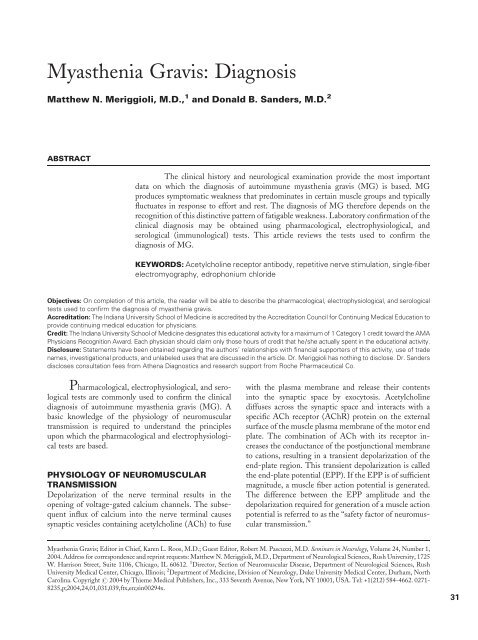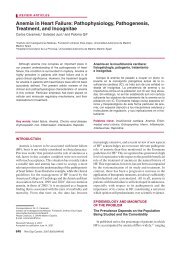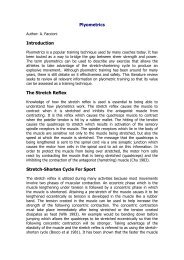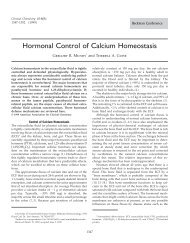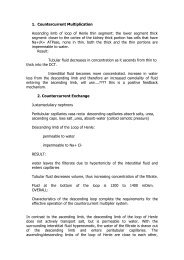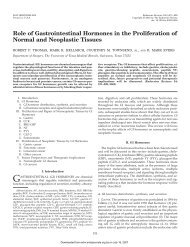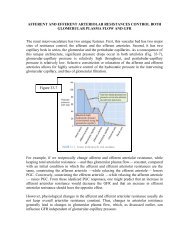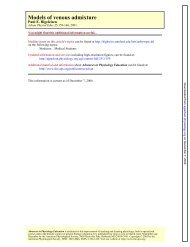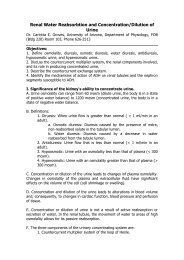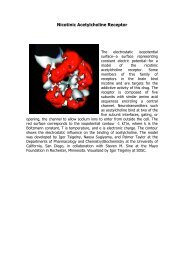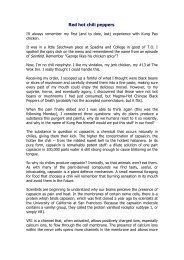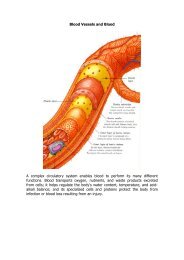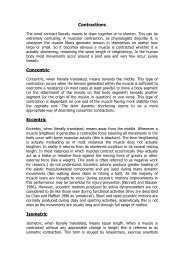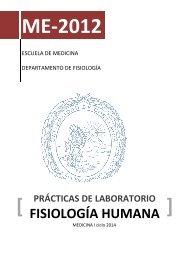Myasthenia Gravis: Diagnosis
Myasthenia Gravis: Diagnosis
Myasthenia Gravis: Diagnosis
Create successful ePaper yourself
Turn your PDF publications into a flip-book with our unique Google optimized e-Paper software.
<strong>Myasthenia</strong> <strong>Gravis</strong>: <strong>Diagnosis</strong>Matthew N. Meriggioli, M.D., 1 and Donald B. Sanders, M.D. 2ABSTRACTThe clinical history and neurological examination provide the most importantdata on which the diagnosis of autoimmune myasthenia gravis (MG) is based. MGproduces symptomatic weakness that predominates in certain muscle groups and typicallyfluctuates in response to effort and rest. The diagnosis of MG therefore depends on therecognition of this distinctive pattern of fatigable weakness. Laboratory confirmation of theclinical diagnosis may be obtained using pharmacological, electrophysiological, andserological (immunological) tests. This article reviews the tests used to confirm thediagnosis of MG.KEYWORDS: Acetylcholine receptor antibody, repetitive nerve stimulation, single-fiberelectromyography, edrophonium chlorideObjectives: On completion of this article, the reader will be able to describe the pharmacological, electrophysiological, and serologicaltests used to confirm the diagnosis of myasthenia gravis.Accreditation: The Indiana University School of Medicine is accredited by the Accreditation Council for Continuing Medical Education toprovide continuing medical education for physicians.Credit: The Indiana University School of Medicine designates this educational activity for a maximum of 1 Category 1 credit toward the AMAPhysicians Recognition Award. Each physician should claim only those hours of credit that he/she actually spent in the educational activity.Disclosure: Statements have been obtained regarding the authors’ relationships with financial supporters of this activity, use of tradenames, investigational products, and unlabeled uses that are discussed in the article. Dr. Meriggioli has nothing to disclose. Dr. Sandersdiscloses consultation fees from Athena Diagnostics and research support from Roche Pharmaceutical Co.Pharmacological, electrophysiological, and serologicaltests are commonly used to confirm the clinicaldiagnosis of autoimmune myasthenia gravis (MG). Abasic knowledge of the physiology of neuromusculartransmission is required to understand the principlesupon which the pharmacological and electrophysiologicaltests are based.PHYSIOLOGY OF NEUROMUSCULARTRANSMISSIONDepolarization of the nerve terminal results in theopening of voltage-gated calcium channels. The subsequentinflux of calcium into the nerve terminal causessynaptic vesicles containing acetylcholine (ACh) to fusewith the plasma membrane and release their contentsinto the synaptic space by exocytosis. Acetylcholinediffuses across the synaptic space and interacts with aspecific ACh receptor (AChR) protein on the externalsurface of the muscle plasma membrane of the motor endplate. The combination of ACh with its receptor increasesthe conductance of the postjunctional membraneto cations, resulting in a transient depolarization of theend-plate region. This transient depolarization is calledthe end-plate potential (EPP). If the EPP is of sufficientmagnitude, a muscle fiber action potential is generated.The difference between the EPP amplitude and thedepolarization required for generation of a muscle actionpotential is referred to as the ‘‘safety factor of neuromusculartransmission.’’<strong>Myasthenia</strong> <strong>Gravis</strong>; Editor in Chief, Karen L. Roos, M.D.; Guest Editor, Robert M. Pascuzzi, M.D. Seminars in Neurology, Volume 24, Number 1,2004. Address for correspondence and reprint requests: Matthew N. Meriggioli, M.D., Department of Neurological Sciences, Rush University, 1725W. Harrison Street, Suite 1106, Chicago, IL 60612. 1 Director, Section of Neuromuscular Disease, Department of Neurological Sciences, RushUniversity Medical Center, Chicago, Illinois; 2 Department of Medicine, Division of Neurology, Duke University Medical Center, Durham, NorthCarolina. Copyright # 2004 by Thieme Medical Publishers, Inc., 333 Seventh Avenue, New York, NY 10001, USA. Tel: +1(212) 584-4662. 0271-8235,p;2004,24,01,031,039,ftx,en;sin00294x.31
32 SEMINARS IN NEUROLOGY/VOLUME 24, NUMBER 1 2004The EPP is transient because the action of ACh isended by its hydrolysis to choline and acetate by theenzyme acetylcholinesterase (AChase), which is presentin high concentrations at the postsynaptic membrane.After the end-plate region is depolarized, adjacent regionsof the muscle cell membrane are depolarized byelectrotonic conduction. When these regions reachthreshold, action potentials are generated that are propagatedalong the muscle fiber at high velocities, initiatingthe chain of events that lead to muscle contraction.Muscle-specific tyrosine receptor kinase (MuSK)is an enzyme on the receptor region of the musclemembrane that is essential in aggregating AChRs inthe developing muscle. Muscle-specific tyrosine receptorkinase is activated by nerve-released agrin. Its role inmature muscle is not yet clear, but antibodies to MuSKhave been demonstrated in 40% of patients withgeneralized acquired MG who do not have antibodiesto the AChR.PHARMACOLOGICAL TESTINGClinical observation of the response to administration ofpharmacological agents that affect neuromuscular transmissionforms the basis for several diagnostic tests.These include tests that demonstrate improved strengthinduced by agents that enhance neuromuscular transmission(e.g., edrophonium, pyridostigmine) or an exaggeratedresponse to agents that block the neuromuscularjunction (e.g., curare). With the development of sensitiveelectrophysiological tests, the latter are no longerroutinely used.are relative contraindications for edrophonium testing.Resolution of eyelid ptosis or improvement in strengthof at least one paretic extraocular muscle are the mostreliable end points. Although widely used and generallyaccepted, the edrophonium test is neither absolutelysensitive nor specific for MG. 3–6 It is limited by thedependence on patient effort to give maximal exertionboth before and after the drug is administered. For thisreason, diagnostic sensitivity and specificity are acceptableonly in patients with clear-cut weakness in musclesthat can be assessed in a serial and objective manner (i.e.,ptosis or ophthalmoparesis).Other Cholinesterase InhibitorsSome patients with MG do not improve after administrationof edrophonium, but respond to neostigminemethylsulfate or Prostigmin. 7,8 The onset of action afteran intramuscular dose is 5 to 15 minutes, and theclinical effects last from 2.5 to 4 hours. This longerduration of action compared with edrophonium is potentiallyuseful in the evaluation of children. However,the reliability of the selected end point is often questionablein the interpretation of diagnostic trials usinglonger-acting cholinesterase inhibitors, and this severelylimits their diagnostic value. Similarly, administration oforal pyridostigmine (Mestinon) as a therapeutic trialmay demonstrate a subjective beneficial effect on musclestrength and fatigability that is not apparent after asingle dose of edrophonium. Once again, caution isrecommended in interpreting these trials as they relylargely on the patient’s subjective observations.Edrophonium Chloride (Tensilon) TestThe use of edrophonium chloride (Tensilon) as a diagnostictest for MG was described in 1952. 1 Its rapidonset (30 seconds) and short duration of effect(5 minutes) make it an ideal agent for this purpose.By inhibiting the normal action of AChase, edrophoniumchloride and other cholinesterase inhibitors allowACh molecules to diffuse more widely throughout thesynaptic cleft and to interact with AChRs sequentially,resulting in a larger and longer EPP. 2The dose of edrophonium that will produce improvementvaries among patients and cannot be predictedin advance. A dose that is too high may exacerbateweakness in patients with abnormal neuromusculartransmission. For this reason, edrophonium is administeredin incremental doses, beginning with a test dose of2 mg, followed by doses of 3 and 5 mg. Atropine (0.6 mgintramuscularly or intravenously) should be available tocounter possible muscarinic side effects, although thedose of edrophonium typically needed to diagnose MGis rarely more than 5 mg and unlikely to cause significantproblems. Bronchial asthma and cardiac dysrhythmiasELECTROPHYSIOLOGICAL TESTINGElectrophysiological studies are performed in patientswith suspected MG to confirm a defect in neuromusculartransmission and also to exclude other diseases ofthe motor unit that may confound or contribute to theclinical findings. The two principal electrophysiologicaltests used to confirm a defect in neuromuscular transmissionare repetitive nerve stimulation (RNS) studiesand single-fiber electromyography (SFEMG).Repetitive Nerve StimulationRNS is the most commonly used electrophysiologicaltest of neuromuscular transmission. In this technique, aperipheral nerve is stimulated supramaximally and thecompound muscle action potential (CMAP) is recorded.The CMAP is recorded with a surface electrode placedover the motor point of the muscle and a referencerecording electrode placed on a distal point where minimalelectrical activity is recorded, usually a tendon orbony prominence. Repetitive nerve stimulation serves to‘‘stress’’ motor end plates with marginal safety factors by
MYASTHENIA GRAVIS: DIAGNOSIS/MERIGGIOLI, SANDERS 33depleting the store of readily releasable synaptic vesicles.In clinical practice, a train of 5 to 10 stimuli is deliveredat a rate of 2 to 3 Hz. This rate is effective for this purposebecause it normally results in a sequential decreasein the amount of ACh released from the nerve terminal.This phenomenon becomes crucial in myasthenic endplates when the EPP drops below threshold. As theEPP drops below threshold for muscle fiber activation inan increasing number of end plates, the number ofmuscle fibers contributing to the CMAP declines andthe resulting CMAP is reduced in amplitude and area(decremental response) (Fig. 1B).Fast rates of stimulation (>10 Hz) in patientswith neuromuscular junction disease may produce anincrease in CMAP amplitude due to buildup of calciumin the nerve terminal and the resulting facilitated releaseof ACh (posttetanic facilitation). This occurs only indiseased end plates as normally all EPPs result in musclefiber action potential generation, and the facilitatedrelease of added ACh is of no consequence. In normalor abnormal end plates, a rapid rate of stimulation mayresult in an increased CMAP amplitude by increasingsynchronization of the action potential velocities in thetested muscle fibers 9 or by hyperpolarization of themuscle fiber membrane from increased Na þ -K þ pumping.10 This produces a CMAP of increased amplitudebut decreased duration (the negative peak area is essentiallyunchanged). This phenomenon is called ‘‘pseudofacilitation’’and is not indicative of neuromuscularjunction disease but may mask a decrement.In repetitive nerve stimulation testing, the decrementis defined as the percentage of change between theamplitude or area of the fourth, fifth, or lowest potential(usually the fourth) compared with the first potential.The area is a more accurate measure of the numberof muscle fibers contributing to the CMAP and isusually not affected by pseudofacilitation. However,area measurements are affected by the G2 electrode,repolarization, and muscle fiber fatigue and are markedlydependent on filter settings. In most cases, the resultsfrom area and amplitude measurements are concordant.Any discrepancy should lead to a search for technicalproblems.A decrement greater than 10% is consideredabnormal. However, the criteria for abnormality willvary to some degree between laboratories. The followingtechnical considerations are useful to maximize diagnosticsensitivity and prevent artifactual changes:1. Reproducibility. The same decrement should be acquiredon repeat testing after a period of rest. Themuscle should be rested for at least 30 secondsFigure 1 Repetitive nerve stimulation tracings from a normal control subject (A) and a patient with myasthenia gravis (B) illustrating aclassic decremental response. Responses were obtained with repetitive stimulation of the ulnar nerve at 3 Hz, recording from theabductor digiti minimi muscle. (C) A prominent decrement is seen in another patient with MG. Comparing the amplitude of the firstpotential with the fourth potential (arrow), there is a 24% decrement. (D) Immediately after 30 seconds of exercise, the decrement isnow much less (‘‘repair of the decrement’’). (E) Four minutes after exercise the decrement is now worsened (32%) compared with theresting baseline (postactivation exhaustion).
34 SEMINARS IN NEUROLOGY/VOLUME 24, NUMBER 1 2004between trials. The average decrement after threetrials may be reported and is often more accuratethan the measurement after a single trial. Widelyvarying measurements from one trial to another arean indication of poor technique or may be caused byincomplete muscle relaxation.2. Response (envelope) pattern. Movement of the stimulatingor recording electrodes, or the muscle itself,may produce irregular patterns of change in CMAPsize and configuration during repetitive stimulation.It is important to recognize these patterns as notconforming to those expected in disease of the neuromuscularjunction. Stimulating and recording electrodesand the appropriate joints should be stabilizedto minimize these artifactual changes.3. Muscle temperature. The decremental response in endplatediseases is less when the muscle is cool. 11 Handor foot muscles should be warmed to at least 36 Ctoensure the maximum diagnostic sensitivity.4. AChase medications may mask a decrement and shouldbe stopped at least 12 hours prior to the study.Caution is required in certain patients who aredependent on these medications, as this may producea disease exacerbation.The typical pattern seen with repetitive nervestimulation at 2 to 3 Hz in a patient with MG is aprogressive decrement of the second through the fourthor fifth response with some return toward the initialCMAP size during the subsequent responses to a trainof stimuli, the so-called ‘‘U-shaped pattern’’ (Fig. 1).Voluntary activation of the tested muscle by sustainedcontraction for 30 to 60 seconds or longer often producescharacteristic repetitive nerve stimulation findings inpatients with postsynaptic disorders such as MG. Immediatelyafter activation of a muscle in a patient withMG, there may be a modest increase in the size ofthe baseline CMAP and a ‘‘repair of the decrement’’(Fig. 1D). After 2 to 5 minutes, a worsening of thedecremental response compared with preexercise valuesor postactivation exhaustion (PAE) is seen (Fig. 1E). Insome muscles, particularly in patients with mild disease,an abnormal decrement may be seen only during thePAE stage.Repetitive nerve stimulation studies demonstratean abnormal decrement in an extremity muscle (hand orshoulder) in only 60% of patients with MG, beingmore sensitive in generalized disease. Repetitive nervestimulation is more likely to be abnormal in a proximalor facial muscle in patients with MG, 9 and multiplemuscles should be tested to obtain the maximal diagnosticyield. A list of commonly tested nerves and theadvantages and disadvantages of each is given in Table 1.The ulnar, median, and musculocutaneous nervesare useful if the patient’s symptoms are most prominentin the extremities. When signs and symptoms are limitedto ocular or bulbar muscles, it is not unusual for RNSstudies to be completely normal if only extremity musclesare tested. The yield may be improved by testing facialmuscles or the masseter, particularly in patients withpurely ocular or oculobulbar weakness. 12 Most laboratoriesconsider that a complete evaluation for neuromuscularjunction disease includes repetitive nervestimulation testing of at least three muscles. A reproducibledecrement of greater than 10% in two musclesconstitutes a definite electrodiagnosis of a primary defectin neuromuscular transmission, as long as primary disordersof nerve and muscle are excluded. Patientswith neuropathic disease, particularly when associatedwith active denervation/reinnervation (e.g., amyotrophiclateral sclerosis) may have an abnormal decrement onRNS testing. 13 Once a proximal or facial muscle is testedand is negative in a patient with predominantly oculobulbarsymptoms, it is reasonable to proceed directly toSFEMG.SFEMGSFEMG is a selective recording technique in which aspecially constructed concentric needle is used to identifyand record action potentials from individual musclefibers. SFEMG is the most sensitive clinical test fordetection of a defect in neuromuscular transmission. Itssensitivity allows for demonstration of abnormalities inTable 1Nerves and Muscles Tested with RNSNerve Muscle Advantages DisadvantagesUlnar ADM Well tolerated, easy, reliable recordings InsensitiveMedian APB Well tolerated, easy, reliable recordings InsensitiveSpinal accessory Trapezius Sensitive, well tolerated Difficult to exerciseMusculocutaneous Biceps Sensitive Difficult to immobilizeAxillary Deltoid Sensitive Immobilization and stimulation difficultPeroneal EDB Easy to stimulate and exercise InsensitiveFacial Nasalis or orbicularis oculi Sensitive Poorly tolerated, immobilization andstimulation difficultPhrenic Diaphragm Probably sensitive Poorly tolerated, technically difficultRNS, repetitive nerve stimulation; ADM, adductor digit minimi; APB, abductor pollicis brevis; EDB, extensor digitorum brevis.
MYASTHENIA GRAVIS: DIAGNOSIS/MERIGGIOLI, SANDERS 35clinically unaffected muscles. 14 When the motor nerve isstimulated or activated voluntarily, the latency fromnerve activation to muscle action potential varies fromdischarge to discharge. This variation is the neuromuscularjitter and is produced by fluctuations in the timeit takes for the EPP at the neuromuscular junctionto reach the threshold for action potential generation.These fluctuations are in turn due to the normallyvarying amount of ACh released from the nerve terminalafter a nerve impulse. A small amount of jitter is seen innormal muscles due to this phenomenon. An increase inthe magnitude of this jitter is the most sensitive electrophysiologicalsign of a defect in neuromuscular transmission.When the defect in neuromuscular transmission ismore severe, some nerve impulses fail to elicit actionpotentials and SFEMG recordings demonstrate intermittentimpulse blocking. SFEMG recordings demonstratethis as an intermittent absence of one or moresingle muscle fiber action potentials on consecutivefirings (Fig. 2).SFEMG studies can be performed during eithermild voluntary activation of the muscle under study orwith axonal microstimulation. Jitter measurements performedduring voluntary activation of the muscle are lesssubject to technical problems but are more dependent onpatient cooperation. As the patient minimally contractsthe muscle under study, the examiner positions therecording electrode to record two or more time-lockedaction potentials. A constant recording position is maintaineduntil at least 50 discharges are recorded (Fig. 3).At least 20 potential pairs from different areas in themuscle should be sampled, taking care not to measurethe same pair of potentials more than once. Jitter ismeasured as the variation in the time interval betweenthe two action potentials in the pair (interpotentialinterval) and represents the combined jitter in two endplates.In jitter studies performed with axonal microstimulation,action potentials from single muscle fibers arerecorded during stimulation of motor nerve fibers with amonopolar needle inserted near the nerve. 15 The stimulusto response interval is determined for a series of 50 to100 stimulations, and the variability of these intervals is ameasure of the jitter in a single end plate. This techniqueis prone to several pitfalls and misinterpretations but isuseful when patients cannot sustain muscle contraction.16 Jitter is calculated as the mean difference betweenconsecutive interpotential intervals (or stimulus responseintervals).The mean jitter of all fiber pairs or end plates,the percentage with normal jitter, abnormal jitter, andFigure 2 Method of single-fiber electromyography with voluntary activation. The single-fiber needle is inserted into voluntarilyactivated muscle and is positioned so that recordings are obtained from two or more single muscle fibers belonging to the same motorunit. One single muscle fiber action potential serves as a time reference and the interpotential interval (IPI) is measured afterconsecutive discharges between the reference potential and subsequent time-locked potentials. In disorders of the neuromuscularjunction, there may be marked variability of the IPI (abnormal jitter). If severe, neuromuscular transmission failure may occur in which theEPP amplitude fails to reach the threshold for action potential generation. This is demonstrated here by the absence of the secondrecorded fiber pair when the EPP in the second muscle fiber (EPP 2 ) is subthreshold (dotted lines and arrows).
36 SEMINARS IN NEUROLOGY/VOLUME 24, NUMBER 1 2004Figure 3 Jitter recordings obtained during voluntary activation from the extensor digitorum communis muscle in (A) a normal controlsubject (100 consecutive discharges are superimposed) and (B) a patient with myasthenia gravis (52 consecutive discharges aresuperimposed). Horizontal lines with brackets indicate the trigger windows within which the interpotential intervals are measured.impulse blocking are calculated and reported for eachmuscle tested. A study is abnormal if the mean jitter ofall fiber pairs (or end plates) exceeds the upper limitof normal for that muscle, or if more than 10% of pairsor end plates have jitter that exceeds the upper limit ofnormal for jitter in that muscle. Reference values forjitter during voluntary activation have been determinedfor several muscles in a multicenter collaborative study. 17Normal jitter values for axonal stimulation studies havebeen determined for some muscles. 18 For other muscles,the normal values for stimulated jitter can be calculatedby dividing the values for voluntarily activated jitterby 1.4.SFEMG demonstrates increased jitter in virtuallyall patients with MG if appropriate muscles are tested.Jitter is greatest in weak muscles but is usually increasedeven in muscles with normal strength. A list of frequentlytested muscles is given in Table 2. Facial musclesare often more abnormal than limb muscles in most MGpatients, and it may be necessary to test several musclesTable 2 Muscles Tested with SFEMGMuscle Advantages DisadvantagesEDCEasy to activate and test, relatively free ofNot as sensitive in ocular or oculobulbar diseaseage-related changesOrbicularis oculi Sensitive in generalized or purely ocular disease Thin muscle: five to six separate insertions necessary toprevent duplicate testing of fiber pairs; difficult tomaintain steady activationFrontalis Sensitive in generalized or purely ocular disease,easily activatedThin muscle: five to six separate insertions necessary toprevent duplicate testing of fiber pairsMasseter Potentially useful in predominantly bulbar weakness; Normal values not determined, sensitivity not establishedeasily activatedNeck extensors May be most abnormal muscle in some patients Normal values not determined, sensitivity not establishedwith MuSK-positive MG; easily activatedDeltoid Alternative to facial muscle in generalized disease Sensitivity not established, difficult to activate selectivelyBiceps Alternative to facial muscle in generalized disease Sensitivity not established, difficult to activate selectivelyQuadriceps Potentially useful with predominant weakness in Sensitivity not established, difficult to activate selectivelylower extremitiesTAPotentially useful with predominant weakness inlower extremitiesSensitivity not established, false-positive result a concernas often involved in root/peripheral nerve diseaseSFEMG, single-fiber electromyography; EDC, extensor digitorum communis; TA, tibialis anterior.
MYASTHENIA GRAVIS: DIAGNOSIS/MERIGGIOLI, SANDERS 37to demonstrate abnormal jitter in patients with mild orpurely ocular weakness. The finding of normal jitter in aclinically weak muscle essentially rules out a defect inneuromuscular transmission as a cause for the weakness.It is important to understand that the enhanced sensitivityof SFEMG comes at the price of reduced specificity.Jitter may be increased in primary nerve or evenmuscle disease, and these disorders must be excluded bythe appropriate electrophysiological and clinical examinationsbefore concluding that the patient has MG. 19,20SEROLOGICAL (IMMUNOLOGICAL)TESTINGAnti-AChR AntibodiesAntibodies to the AChR and their effects on AChRnumber and function are generally regarded as the mostspecific diagnostic markers for MG. Antibodies bindingto the AChR are present in 85% of patients with MGas measured by the conventional radioimmunoprecipitationassay. 21,22 The serum level of AChR binding antibodiesvaries widely among patients with similar degreesof weakness. The concentration of antibodies may below at symptom onset and become elevated later; thus,repeat testing may be appropriate when initial valuesare normal. Normal AChR binding antibody concentrationsdo not exclude the diagnosis, even in generalizedMG. Virtually all MG patients with thymoma willhave elevated AChR binding antibodies. The diagnosticspecificity for MG is quite good, although increasedtiters may rarely be found in autoimmune liver disease,systemic lupus, inflammatory neuropathies, amyotrophiclateral sclerosis, as well as in patients with thymomawithout MG, in first-degree relatives of patientswith acquired autoimmune MG, and in patients withLambert-Eaton myasthenic syndrome. 23AChR modulating antibodies bind to exposedsegments of the AChR on skeletal muscle membranes. 24Elevated levels of these antibodies are typically foundin generalized MG and MG associated with thymoma,but are most useful when the AChR binding assay isnegative, which occurs in 3 to 4% of patients. 24 AChRblocking antibodies bind at or near the neurotransmitterbinding site on the skeletal muscle AChR and aredetectable by a modified immunoprecipitation assay. 24They are found in only 1% of MG patients withoutAChR binding antibodies, making them of limiteddiagnostic utility.Antibodies to Striated Muscle orStriational AutoantibodiesAntibodies to striated muscle (StrAb) were the firstautoantibody discovered in MG. 23 They are reactivewith contractile elements of skeletal muscle. They areelevated in 30% of all adult-onset MG and are highlyassociated with thymoma, being positive in 80% ofMG patients with thymoma and 24% of patients withthymoma without MG. 23,25 The absence of StrAbsdoes not exclude thymoma, and their presence is notabsolutely indicative of thymoma, particularly in elderlypatients. 23 Antibodies to striated muscle are most usefulas a marker of thymoma in patients with MG onsetbefore age 40. Antibodies to striated muscle may alsobe a valuable marker in middle-aged or elderly patientswith mild MG, where they can be the only serologicalabnormality. False-positives rarely occur in patients withrheumatoid arthritis who are treated with penicillamine,in 3 to 5% of patients with Lambert-Eaton myasthenicsyndrome, and in recipients of bone marrow allograftswith graft-versus-host disease. 23Antibodies to Other Skeletal Muscle ProteinsSome patients with MG have antibodies directed againstskeletal muscle antigens in addition to the AChR.Antibodies to the intracellular striated muscle proteintitin and antibodies to the ryanodine receptor may befound in MG patients with thymoma and in a proportionof patients with late-onset MG. Approximately95% of MG patients with thymoma have titin antibodies,but so do 50% of patients with late-onset nonthymomatousMG. 26 Ryanodine antibodies are found in75% of MG patients with thymoma but are more specificand are often associated with the presence of a malignantthymoma. 26 The role of these antibodies in diseasepathogenesis has not been determined, although patientswith titin and/or ryanodine antibodies tend to havemore severe disease and may be less responsive totreatment. Therefore, the presence of these antibodiesmay potentially be useful in assessing disease prognosisand treatment.‘‘Seronegative MG’’It is becoming more apparent that patients with‘‘seronegative’’ generalized MG (SNMG) have distinctiveforms of disease compared with AChR antibodypositiveMG. A proportion of patients with generalizedSNMG have been found to have immunoglobulin Gantibodies to the MuSK, a neuromuscular junctionprotein that plays an important role in the clusteringof AChRs. MuSK antibodies have been reported in 38to 71% of patients with generalized SNMG 27–29 buthave not been found in AChR antibody-positive orocular MG. More recent studies indicate that the trueincidence is probably on the order of 40 to 50% of AChRantibody-negative, generalized MG patients. MuSKpositivepatients may have atypical presentations characterizedby prominent facial, bulbar, neck, shoulder, andrespiratory muscle involvement with relative sparing of
38 SEMINARS IN NEUROLOGY/VOLUME 24, NUMBER 1 2004ocular muscles. In many of these patients, abnormalneuromuscular transmission was preferentially demonstratedby RNS or SFEMG testing of weak muscles,particularly those with weakness restricted to facial orshoulder muscles. They frequently do not respond tocholinesterase inhibitors but improve with plasma exchangeand selected immunotherapy. 29 MuSK antibodiesmay alter the normal maintenance of a high densityof AChRs at the neuromuscular junction, but the confirmationand mechanism of their pathogenic effect hasnot been demonstrated. Studies in SNMG patientswithout MuSK antibodies indicate that their plasmareduces AChR function in cell culture assays. 21 Themechanism of this action and the circulating factor(s)responsible for this effect remain to be defined.COMPARISON OF DIAGNOSTIC TESTSThe edrophonium (Tensilon) test is readily accessible,easy to perform, and abnormal in most patients withMG who have ptosis or ophthalmoparesis. Unfortunately,the results are not entirely objective and a positivetest should be confirmed by more objective means(electrophysiological or serological testing). RNS is theleast sensitive of the diagnostic techniques, but hasthe advantage of being widely available and relativelysimple to perform. Although SFEMG is clearly themost sensitive technique, it requires special equipmentand training and is time- and labor-intensive. It alsodetects neuromuscular transmission abnormalities inprimary disorders of nerve and muscle, and these mustbe excluded before a diagnosis of MG is made. SFEMGis most valuable in patients with mild or purely ocular oroculobulbar disease, particularly when immunologicaltests are negative. It is also valuable in excluding adisorder of neuromuscular transmission, as the findingof normal jitter in a weak muscle indicates the weaknessis not due to a defect in neuromuscular transmission.Currently, detection of elevated levels of AChR bindingantibodies is the most specific test for MG, althoughlevels are normal in up to 15% of patients. A proportionof MG patients with AChR antibody-negative, generalizeddisease may have detectable MuSK antibodies. Thesensitivity of the various diagnostic tests in MG 30 isshown in Table 3.Table 3 Comparison of Diagnostic Tests in 550 Patientswith MG 31 Edrophonium RNS AChR-ab SFEMGGeneralized (%) 91 76 80–85 99Ocular (%) 84 48 55 97MG, myasthenia gravis; RNS, repetitive stimulation in distal hand andshoulder muscle; AChR-ab, acetylcholine receptor binding antibodies;SFEMG, single-fiber electromyography of at least one muscle.DIAGNOSTIC APPROACHOnce the clinical diagnosis of MG is made, bloodsamples for AChR binding antibodies and striationalantibodies should be obtained. The latter is obtainedmainly to increase diagnostic yield in late-onset MG andto assess for thymoma in younger patients. In most cases,these tests will require up to 10 days for results to becomeavailable. A provisional diagnosis may be made using theedrophonium test if the patient has clear eyelid ptosisor ophthalmoparesis that can be serially followed. Electrophysiologicaltesting offers the opportunity to make amore definitive diagnosis. Patients with generalizedMG, particularly with limb weakness, may be evaluatedusing RNS studies, which should optimally be performedin a weak muscle. Once a proximal or facial muscle isnegative, it is reasonable to proceed to SFEMG. Inpatients without clinical limb weakness, initial evaluationwith SFEMG is appropriate. Once the diagnosis isconfirmed by either electrophysiological or serologicaltesting, computed tomography (CT) of the chest shouldbe obtained to rule out the presence of an underlyingthymoma. Titin and/or ryanodine antibodies may beuseful in predicting the presence of thymoma in certaincases, but the added yield compared with a chest CT isquestionable. MG patients with generalized disease whodo not have AChR antibodies should be tested forMuSK antibodies, particularly if their clinical presentationis atypical.REFERENCES1. Osserman KE, Kaplan LI. Rapid diagnostic test for myastheniagravis: increased muscle strength, without fasciculationsafter intravenous administration of edrophonium(Tensilon) chloride. J Am Med Assoc 1952;150:265–2682. Katz B, Miledi R. The binding of acetylcholine to receptorsand its removal from the synaptic cleft. J Physiol 1973;231:549–5743. Daroff RB. The office Tensilon test for ocular myastheniagravis. Arch Neurol 1986;43:843–8444. Dirr LY, Donofrio PD, Patton JF, Troost BT. A falsepositiveedrophonium test in a patient with a brainstemglioma. Neurology 1989;39:865–8675. Fierro B, Croce G, Filosto L, Carbone N, Lupo I. Ocularpseudomyasthenia: report of a case with a pineal region tumor.Ital J Neurol Sci 1991;12:593–5966. Branley MG, Wright KW, Borchert MS. Third nerve palsydue to cerebral artery aneurysm in a child. Aust N Z JOphthalmol 1992;20:137–1407. Rowland LP. Prostigmine-responsiveness and the diagnosisof myasthenia gravis. Neurology 1955;5:612–6248. Viets HR, Schwab RS. Prostigmine in the diagnosis ofmyasthenia gravis. N Engl J Med 1935;213:1280–12839. Howard JF, Sanders DB, Massey JM. The electrodiagnosisof myasthenia gravis and the Lambert-Eaton myasthenicsyndrome. Neurol Clin 1994;12:305–32910. McComas AJ, Galea V, Einhorn RW. Pseudofacilitation: amisleading term. Muscle Nerve 1994;17:599–607
MYASTHENIA GRAVIS: DIAGNOSIS/MERIGGIOLI, SANDERS 3911. Borenstein S, Desmedt JE. Local cooling in myasthenia.Improvement in neuro- muscular failure. Arch Neurol 1975;32:152–15712. Niks EH, Badrising UA, Verschuuren JJ, van Dijk JG.Decremental response of the nasalis and hypothenar musclesin myasthenia gravis. Muscle Nerve 2003;28:236–23813. Killian JM, Wilfong AA, Burnett L, Appel SH, Boland D.Decremental motor responses to repetitive nerve stimulationin ALS. Muscle Nerve 1994;17:747–75414. Sanders DB, Stlberg E. AAEM minimonograph # 25: singlefiberelectromyography. Muscle Nerve 1996;19:1069–108315. Trontelj JV, Stlberg EV. Jitter measurement by axonal microstimulation.Guidelines and technical notes. ElectroencephalogrClin Neurophysiol 1992;85:30–3716. Stlberg E, Trontelj JV, Mihelin M. Electrical microstimulationwith single-fiber electromyography: a useful method tostudy the physiology of the motor unit. J Clin Neurophysiol1992;9:105–11917. Gilchrist JM. ad hoc Committee. Single fiber EMG referencevalues: a collaborative effort. Muscle Nerve 1992;15:151–16118. Trontelj JV, Khuraibet A, Milhelin M. The jitter instimulated orbicularis oculi muscle: technique and normalvalues. J Neurol Neurosurg Psychiatry 1988;51:814–81919. Mercelis R. Abnormal single fiber electromyography inpatients not having myasthenia. Ann N Y Acad Sci 2003;998:509–51120. Sanders DB. Clinical impact of single-fiber electromyography.Muscle Nerve 2002;11(suppl):S15–S2021. Vincent A, McConville J, Farrugia E, et al. Antibodies inmyasthenia gravis and related disorders. Ann N Y Acad Sci2003;998:324–33522. Vincent A, Newsom-Davis J. Acetylcholine receptor antibodyas a diagnostic test for myasthenia gravis: results in 153validated cases and 2967 diagnostic assays. J Neurol NeurosurgPsychiatry 1985;48:1246–125223. Lennon VA. Serological diagnosis of myasthenia gravis andLambert-Eaton myasthenic syndrome. In: Lisak RP, ed.Handbook of <strong>Myasthenia</strong> <strong>Gravis</strong> and Myasthenic Syndromes.New York: Marcel Dekker; 1994:149–16424. Howard FM, Lennon V, Finley J, Matsumoto J, ElvebackLR. Clinical correlations of antibodies that bind, block ormodulate human acetylcholine receptors in myasthenia gravis.<strong>Myasthenia</strong> gravis: biology and treatment. Ann N Y Acad Sci1987;505:526–53825. Cikes N, Momoi MY, Williams CL, et al. Striationalautoantibodies: quantitative detection by enzyme immunoassayin myasthenia gravis, thymoma, and recipients ofD-penicillamine or allogeneic bone marrow. Mayo Clin Proc1988;63:474–48126. Skeie GO, Romi F, Aarli JA, Bentsen PT, Gilhus NE.Pathogenesis of myositis and myasthenia associated with titinand ryanodine receptor antibodies. Ann N Y Acad Sci 2003;998:343–35027. Hoch W, McConville J, Helms S, Newsom-Davis J,Melms A, Vincent A. Auto-antibodies to the receptortyrosine kinase MuSK in patients with myasthenia graviswithout acetylcholine receptor antibodies. Nat Med 2001;7:365–36828. Scuderi F, Marino M, Colonna L, et al. Anti-P110autoantibodies identify a subtype of ‘‘seronegative’’ myastheniagravis with prominent oculobulbar involvement. LabInvest 2002;82:1139–114629. Sanders DB, El-Salem K, Massey JM, McConville J, VincentA. Clinical aspects of MuSK antibody positive seronegativeMG. Neurology 2003;60:1978–198030. Sanders DB. Diseases associated with disorders of neuromusculartransmission. In: Brown WF, Bolton CF, AminoffMJ, eds. Neuromuscular Function and Disease. Basic,Clinical, and Electrodiagnostic Aspects. Philadelphia: W.B.Saunders; 2001:1346–1347


